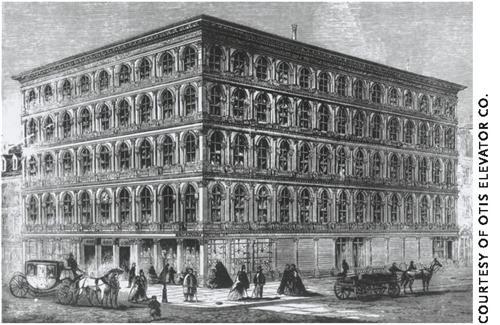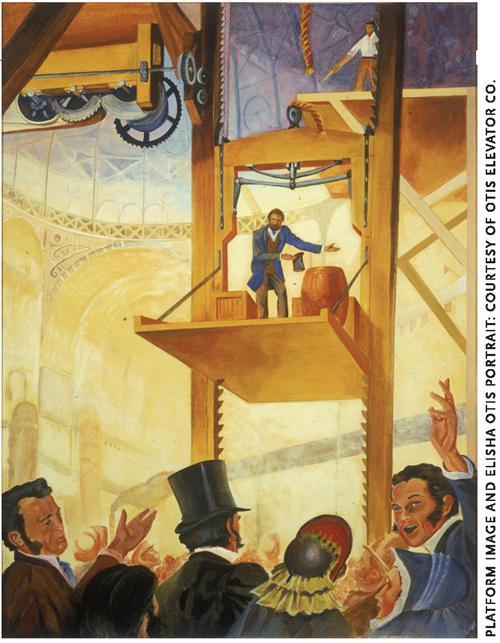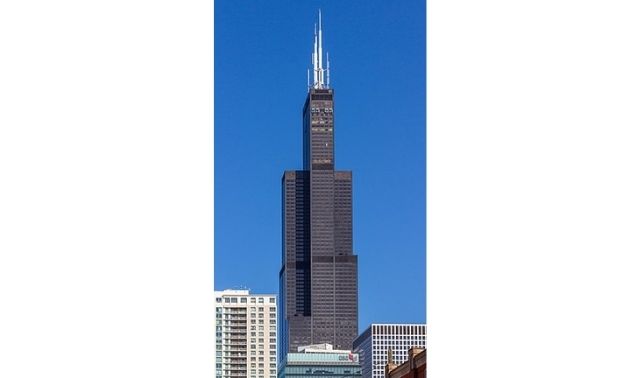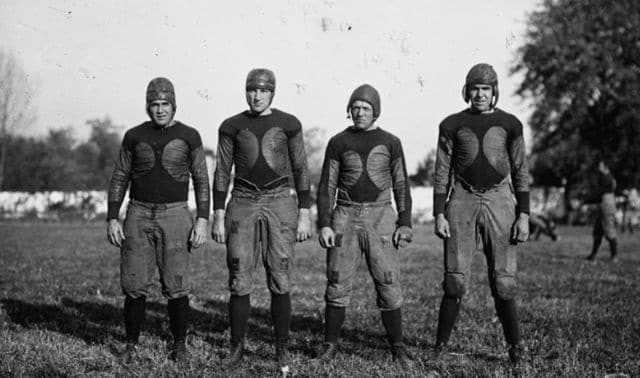Sign up for the Family Tree Newsletter! Plus, you’ll receive our 10 Essential Genealogy Research Forms PDF as a special thank you.
Get Your Free Genealogy Forms
"*" indicates required fields
Our ancestors lived their lives pretty much horizontally, their vertical ambitions limited by the human capacity to climb stairs. Until, that is, Elisha Graves Otis invented the modern elevator. March 23, 2017, marked the 160th anniversary of Otis’ installation of the first commercial passenger elevator at New York City’s E.V. Haughwout & Co. department store on Broadway and Broome Streets. It took shoppers skyward at the then-astonishing speed of 40 feet per minute, while elevating our ancestors’ architectural aspirations.

With only a little hyperbole, today’s Otis Elevator Co. (a subsidiary of United Technologies Corp.) boasts that Otis’ invention “enabled cities to flourish, revolutionized architecture and laid the foundation for urban centers around the world.”
But Otis almost went panning for gold instead. He’d originally designed his “safety elevator” while working as a master mechanic at the Bedstead Manufacturing Co. in Yonkers, NY. When the company abruptly went bankrupt, Otis decided to join the California gold rush. Just in the nick of time for America’s skylines, however, a Yonkers furniture manufacturer contacted him about replacing its elevator, whose broken cable had cost the lives of two employees. Otis stayed in Yonkers, opening his own shop in part of the former Bedstead building.
Otis’ invention soared into history soon after, in 1854, at P.T. Barnum’s exhibit at New York City’s Crystal Palace (an imitation of London’s famous structure). In a dramatic demonstration of his breakthrough in elevator safety, Otis rode a platform 18 feet to the top of an open shaft; to the gasps of the crowd, the hoisting rope was then cut. A special spring device kept the platform from falling, as Otis proclaimed, “All safe, gentlemen, all safe.”

The subsequent 1857 installation at the Haughwout department store was only the beginning. By the 1870s, more than 2,000 Otis elevators were in service, giving us not only tall buildings but the occupation of elevator operator. Today, Otis elevators move the equivalent of the world’s population every five days.
City skylines change thanks to elevators
Along with such developments as air conditioning and steel — first deployed as a tall building’s skeleton in 1885, in Chicago’s 10-story Home Insurance Building — the elevator transformed the urban landscape. As author Joseph Kellard put it, “The skylines of cities were dramatically redesigned, as stately buildings soaring ever higher were erected and stood as proud boasts of American ingenuity … The businessman no longer needed stretches of land to build on, but looked instead to the limitless sky to take on the soaring creations of his productive mind.”
Nowhere did the skyscraper transform our ancestors’ world as dramatically as the island of Manhattan. The borough’s population density more than doubled from 1880 to 1910, when 113,881 inhabitants per square mile packed into the ever-more-vertical city made possible by elevators and steel. Thousands more commuted to work at places such as the Equitable Life Building — at 42 stories and 1.2 million square feet, then the world’s largest office building. The cityscape was topped in 1930 by the 77-story Chrysler Building, famed for its high-speed elevators, and then by the 102-story Empire State Building, which remained the world’s tallest until the 110-story World Trade Center towers went up in 1972.
Elevator and Skyscraper History Resources
Raise your historical consciousness with these tours, museums and websites:
- Building Big: Skyscrapers
- Canada Science and Technology Museum
- TOP 20 – New York City Best Skyscraper Walking Tour
- Heinz Architectural Center
- MIT Museum
- The Museum for the Preservation of Elevating History (virtual museum)
- National Building Museum
- Self-Guided Chicago Early Skyscrapers Tour
- Skyscraper Page
World Tallest Buildings History Timeline

Park Row Building, New York City
30 floors

Singer Building, New York City
47 floors; first to have an “elevator supervisor” controlling departures by phone

Met Life Tower, New York City
50 floors

Woolworth Building, New York City
57 floors
Bank of Manhattan, New York City
70 floors

Chrysler Building, New York City
77 floors

Empire State Building, New York City
102 floors

Willis Tower (Sears Tower), Chicago
108 floors

Petronas Towers, Kuala Lumpur, Malaysia
88 floors; decorative spires arguably make it taller

Taipei 101, Taipei, Taiwan
101 floors

Burj Khalifa, Dubai, UAE
163 floors
A version of this article appeared in the February 2007 issue of Family Tree Magazine.






